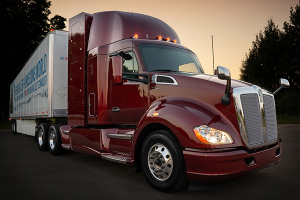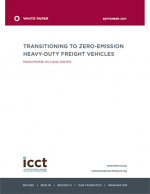Transitioning To Zero-Emission Heavy-Duty Freight Vehicles
In this report, the International Council on Clean Transportation, ICCT, assess zero-emission heavy-duty vehicle technology to support decarbonization of the freight sector and compare the evolution of heavy-duty diesel, diesel hybrid, natural gas, fuel cell, and battery electric technologies in the 2025–2030 timeframe.
A clear path toward decarbonization of the heavy-duty freight sector has been elusive.
Barriers to the growth of electric and hydrogen fuel cell heavy-duty commercial freight trucks include limited technology availability, limited economies of scale, long-distance travel requirements, payload mass and volume constraints, and a lack of refueling and recharging infrastructure.
Many governments and companies are seeking to break down such barriers to help decarbonize heavy-duty freight trucks.
In this report, we synthesize data from the research literature, demonstrations, and low-volume commercial trucks regarding their potential to deliver freight with zero tailpipe emissions.
We analyze the emerging technologies by their cost of ownership and life-cycle greenhouse gas emissions for the three vehicle markets of China, Europe, and the United States.
Based on this work, we assess the relative advantages and disadvantages among the various emerging electric-drive technologies. Table ES-1 summarizes our findings regarding the zero-emission heavy-duty vehicle technology benefits and barriers to widespread adoption.
The table shows results for the three main zero-emission technology areas: plug-in electric, catenary or in-road charging electric, and hydrogen fuel cell vehicles. Each technology offers the prospect of lower carbon emissions, no tailpipe emissions, and greater renewable energy use.
Matching specific electric and hydrogen technologies to particular truck segments can help overcome barriers such as traveling range, infrastructure, and recharging time.
Table ES-1. Summary of promising segments, benefits, and barriers for zero-emission heavy-duty freight vehicle technologies.

We also assess and discuss these factors to better understand the prospects for widespread commercialization over the 2025 and beyond timeframe.
Based on the research findings, we draw the following three conclusions regarding emerging vehicle zero-emission technologies for heavy-duty vehicles;
- Electric-drive heavy-duty vehicle technologies are essential to fully decarbonize the transport sector
- By 2030, electric-drive heavy-duty vehicle technologies could offer cost-effective opportunities for deep emission reductions
- Different electric-drive technologies are suitable for different heavy-duty vehicle segments, but massive infrastructure investments would be needed
What’s Related


Favorites





